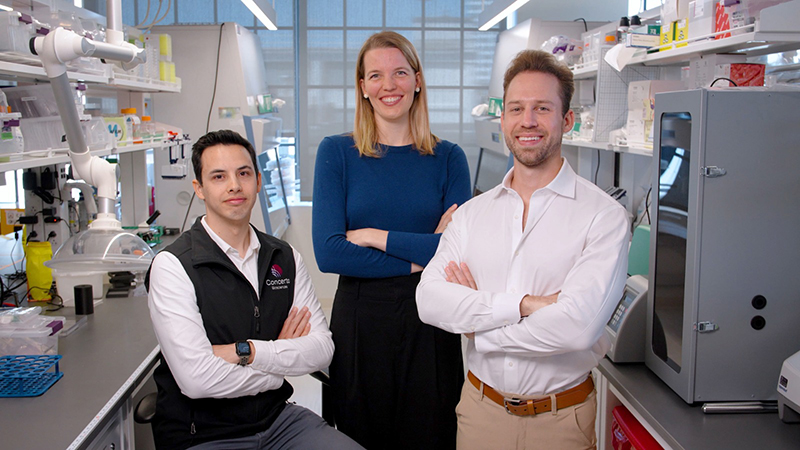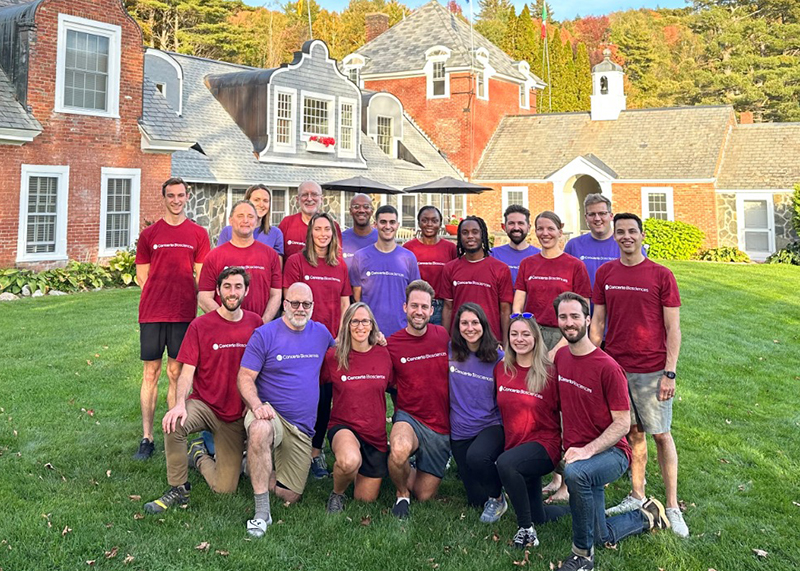Microbial ecology and its potential applications are gaining prominence in biotechnology and healthcare. Cambridge-based Concerto Biosciences is helping drive advances in this area with its kChip technology, designed to unlock breakthroughs across diverse fields—from human health to environmental sustainability.
Concerto Biosciences was one of the companies supported by the National Institutes of Health (NIH) SEED program chosen to present on the NIH Innovation Zone Stage at the 2024 BIO International Convention. Bio.News had the chance to catch up with Concerto Biosciences Cofounder and CEO Cheri Ackerman, Ph.D., Cofounder and Chief Scientific Officer Jared Kehe, Ph.D., and Chief Business Officer Roger Frechette, Ph.D. The following interview has been edited for length.

Q: Could you explain your groundbreaking kChip technology and how it sets Concerto Biosciences apart from other competitors in the marketplace?
Concerto’s kChip technology enables discovery of effective microbe-based therapeutics and consumer products. While at MIT, Concerto cofounder Dr. Jared Kehe co-invented the kChip prototype to address a major disconnect between the natural world and the lab. In nature, microbes work collaboratively to impart our microbiomes with powerful functions like pathogen suppression. But in the lab, microbes are predominantly studied one at a time, isolated from their native communities. In a world where most of us have deficient microbiomes—an issue at the heart of many modern illnesses—we need to discover microbial solutions that capture the fullest capabilities of microbes, solutions that can only be accessed by understanding how microbes work together.
Imagine a combination of microbes that synergistically work together to integrate into a native microbiome and confer some health benefit. From an experimental perspective, identifying that combination is no easy task: There are millions if not billions of combinations we’d want to test! That’s what kChip does. It physically constructs millions of miniature, defined microbial combinations and measures how each affects a biological target of interest. We’re talking about massive data sets, the first of their kind, to systematically reveal how microbes behave combinatorially, just like they do in nature. These data sets are so large, in fact, that we’ve trained AI models to predict the behavior of untested microbial combinations. Aided by this “foundation model” of microbial ecology, Concerto identifies field-changing microbial products across industries as diverse as human health, consumer products, and food ingredients.
Q: What does your technology say about the importance of a One Health approach, not only for public health policy but also for research and development?
At Concerto, we eat, sleep, and breathe ecology: From our core values as an organization to our business model to the mechanisms of our products, we are fundamentally rooted in the notion of interconnectedness and collaboration—concepts at the heart of the One Health philosophy.
There are so many issues grounded in complex interconnectedness: The emergence of disease-causing agents in contaminated water and spoiled food; the transfer of antibiotic resistance from livestock to soil to humans; environmental catastrophes like oil spills; and so forth. Concerto solves these problems by tapping into the interconnectedness of microbial relationships: Imagine microbial consortia that suppress growth of food contaminants, degrade oil, boost crop yield, or improve animal health. All of this is fundamentally accessible through kChip-based discovery work.

Q: Could you discuss Concerto Biosciences’ ongoing partnerships and how greater collaboration within the industry can lead to more breakthroughs?
Companies, like microbes, are stronger together. For Concerto, the ideal collaboration synergizes Concerto’s expertise in microbial product discovery and development with a partner’s domain, marketing, and/or late-stage product development (e.g. clinical or field work) expertise.
While current collaborations are not yet public, we’re happy to discuss Concerto’s approach to partnering. We are internally developing a suite of products for later-stage partnering. They include Ensemble No.2 (ENS-002), a combination of anti-S. aureus topically delivered microbes intended to treat and prevent atopic dermatitis; and Ensemble No.3 (ENS-003), a combination of anti-Candida vaginal microbes intended to treat recurrent vulvovaginal candidiasis. ENS-002 is the furthest along with first-in-human clinical studies scheduled for summer 2024. We will continue to de-risk these assets toward clinical milestones that can attract co-development partnerships.
Beyond these internal assets, Concerto prefers to partner as early as the point of ideating a new product: We’re working toward multiple “co-discovery” efforts spanning broad industry sectors like cosmeceuticals, consumer health ingredients, and agriculture. In these cases, Concerto works with another organization to define a high-value product concept, source the raw materials needed for kChip screening, and identify a lead product candidate for development.
Q: Your company is based in Cambridge, MA, a world-renowned biotech research and development hub. How does being located in this known center of innovation impact your work?
We love the “interactome” of companies, universities, and research institutes that Concerto is embedded in. Our current headquarters is at The Engine, a “tough tech” accelerator in Kendall Square. Kendall is a neighborhood within Cambridge that many consider the global epicenter of life sciences. The density of biotechs, world-renowned academic institutions (including MIT, where Concerto traces its origins as a company!), and biopharma companies offer an outstanding pool of mentorship, talent, and collaborative opportunity. As an added bonus, MassBio has long been a leading industry supporter, and a model for industry associations worldwide—a key to the region’s success that we happily take advantage of.
Q: As a company looking to “create safe, effective, microbial products for our world,” how do you view the issue of antimicrobial resistance and what progress do you hope is made in the next few years in tackling this challenge?
Concerto has reimagined the entire issue of antimicrobial resistance (AMR) from the ground up, both mechanistically and economically, predicated on the idea that microbes are fundamentally our symbionts, not our enemies.
To date, AMR has been addressed by developing more and more small molecule antibiotics, which invariably select for new AMR mechanisms in the target pathogen. The collateral damage of antibiotics is perhaps even more nefarious: Antibiotics wipe out our beneficial microbiomes and can “pathogenize” otherwise harmless microbes by inducing their stress responses and spurring the transfer of mobile genetic elements that confer resistance. As we currently deploy them, antibiotics constitute a declaration of endless war on our symbiotic counterparts. The world needs a completely different strategy.
Concerto is inspired by how our coevolved human-microbe biology addresses microbial pathogens. Human microbiomes have the ability to suppress the outgrowth and pathogenicity of opportunistic microbes that would threaten the survival of the host and its microbial community. Evidence of this includes the infection-curing properties of fecal and vaginal microbiota transplants and the broad repertoire of interspecies interference mechanisms revealed by decades of microbial ecology research. Any infection that originates in a location that has a microbiome (e.g., sinus, gut, vagina, skin) can, in principle, be counteracted by a protective microbial community instead of an antibiotic.
Moreover, microbial community interventions could solve the economic component of the antimicrobial resistance crisis. Developing novel antibiotics is an economic dead end: Each new antibiotic is relegated to “drug of last resort” status, thereby tanking sales in an attempt to avoid driving resistance to the new drug. Because drugs composed of microbial communities can durably resolve an infection, we argue they should be deployed as first-line pathogen control and standard childhood prophylaxis (with antibiotics deployed only when necessary). We encourage stakeholders in our industry—the FDA, government funding agencies, payers, and pharmaceutical companies—to recognize the negative externalities of antibiotics (i.e., increasing rates of AMR, higher rates of autoimmunity and allergy, decreased efficiency of cancer immunotherapy, etc.) and invest in the economically and scientifically sound alternative available to humans through the ancient capabilities of microbial communities.
Learn more about the NIH Small business Education and Entrepreneurial Development (SEED) funding at seed.nih.gov.




